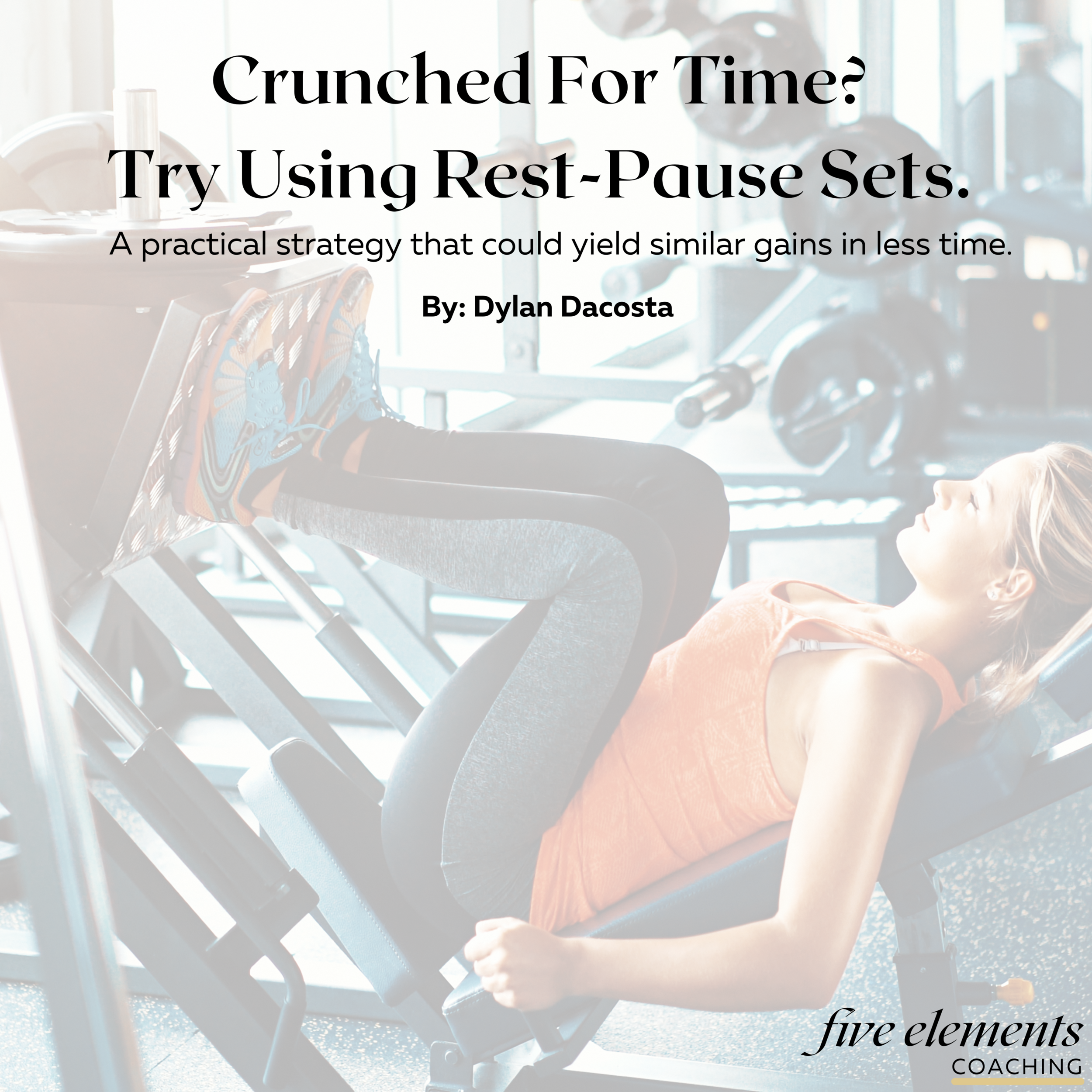Crunched For Time? Try Using Rest-Pause Sets.
A practical strategy that could yield similar gains in less time.
Spark Notes:
Rest-Pause training has been shown to elicit similar responses in strength and muscle growth as traditional strength training does when volume equated.
Since it can be more time efficient, it can be a great strategy to get more efficient yet similarly effective workouts into your schedule.
All of this is contingent on you doing similar training volumes with the rest pause technique, as you would with a more traditional strength workout.
Generally speaking, this technique might be more suited to your lifts that require less skill, are less systematically fatiguing or are more isolation-based.
Read the rest of the article to see how to apply this to your program and even see some example sets and programs. 🍻
Time. The most valuable resource we have. Well, besides the resource of finding a new, addicting show that already has 4+ seasons ready to stream. That has potentially become the new gold of this era.
If we ignore that budding competitor, I think we’d all agree we could use more time.
I constantly feel like I’m at odds with time. Whether it’s not having enough time to train, to unwind, to hangout with my partner/friends, to watch my favourite shows (which may have undermined my previous argument… shit) and everything else I want to do.
With this in mind, and with how commonly I hear about everyone else’s struggles with managing time, I want to bring fourth one strategy that could help save some time in the gym.
The issue when aiming to make more time efficient workouts, is that we also don’t want to sacrifice our gains. With this in mind, I want to talk about one strategy that I’ve really been feelin’ over the last while.
It’s been especially nice to also see some research on this topic being done to further support more effective strategies in this realm.
There are several of methods that we can use, but today I want to talk about rest-pause sets.
The rest-pause set is a simple concept. Instead of doing a more traditional set scheme of say, 3 sets of 8 reps, you would do 1 set with the same weight for as many as you can, followed by a short 20–30 second rest and then going right back at it for as many as you can. This would be repeated until a certain number of reps was done. You would want to match volume in order to make it similar to traditional strength training, though.
In the 3x8 example, that would yield 24 reps with that load.
A rest pause set that matched volume would still want to achieve 24 reps to expect similar results.
This could look like hammerin’ out 10 reps, followed by 6 reps, then 4 reps, then 2 reps and finally another 2 reps. All sets would have a 20–30 second rest in between.
This would be an example of this in the table above. For the traditional sets, the working set itself would take about 30 seconds, plus the 2 min rest. Averaging about 2.5 min per set. For a total of 7–8 minutes approximately.
This rest pause set would usually take about 3–4 working sets to complete. Considering the shorter rest periods, and shorter working sets toward the end, this rarely surpasses 3 mintues. In fact, below you’ll see me doing a rest pause set on the seated leg curl that took 1 minute and 38 seconds.
I’ll also say this isn’t the only way to do a rest-pause set. There’s no rest-pause police that enforce it be done in one way. The only thing that makes it a rest-pause, is that you take shorter rest periods than you normally would and essentially aim for as many reps as you can each set, or at least do less reps per set due to the accumulated fatigue.
If you take a 20–30 second rest and get another 10 reps after getting 10 on the first set, your first set wasn’t nearly hard enough. As this would indicate you only needed 20–30 seconds in order to be able to do that complete set all over again.
Another way you could implement this would be to do 2 rest pause sets as opposed to 3 traditional sets. See an example below.
Both examples here would have 30 reps done at 75% of 1RM. The rest-pause strategy would just save a little more time.
As a side note, don’t worry knowing your % of 1RMs. It’s not that important to most lifters. It’s just to show I was using similar loads and volumes in these examples.
If you do 3 sets of 10 reps at 90 lbs on the chest press, then you’d also want to use 90 lbs to achieve a total of 30 reps using a rest pause technique.
This could look like 1 rest pause set until you hit 30 reps. Or 2 rest pause sets of 10 + 5 reps. Doesn’t matter to much. Whichever works better for you is what I’d aim for.
Will it Yield Similar Results?
In terms of the data that do we have, rest-pause seems to elicit a similar strength and muscle building response as traditional strength training does.
One study did show greater gains in muscle hypertrophy in the rest pause group when compared to traditional set training. But the main issue was that the way the protocol was set up, had the rest pause group progressing through the intervention (progressive overload), while the traditional set group did not make any progressions and did the same load the whole trial. So it was more likely that the RP group had better gains due to the fact they were applying progressive overload, while the traditional set group was not.
A more recent study that did have load progressions for all groups during the study showed more similar results between rest-pause and traditional sets. This study also had a drop-set group too. This is where you take no rest, but just drop the weight immediately and do more reps.
In this study, increases in 1 rep max strength and hypertrophy in the quads were similar amongst all groups.
Above you’ll see that all groups made significant increases in their 1 rep max, but there was no significant difference between groups. You’ll see the rest pause did have the absolute largest increase in strength, but it failed to reach significance here.
Here you’ll see that for the mid and upper thigh, all groups saw significant muscle growth. The rest-pause group actually had the smallest increase compared to the other groups here, but once again, there was nothing significant or even meaningful here between groups. All in all, showing similar gains basically across the board.
Lastly, the sample sizes were pretty small here which is just how it goes when running controlled training studies. So this is nothing against the researchers, as this was a great study. It’s just important to highlight this, as small samples sizes shouldn’t really be used to draw definitive conclusions. More appropriately, we can say that given the data we have, rest-pause training seems to elicit similar results as traditional training. Making it’s time efficiency and even novelty some solid reasons to add it into your training arsenal.
How should I Utilize Rest-Pause Sets?
As we saw in some of the studies above, you do not need to only do rest-pause workouts.
I honestly don’t even recommend that. I suggest using them more with your accessories and less skill based movements.
For example, if you want to get a great squat, I would typically recommend you do straight sets with your squats. This could be used for any movement.
Then, later in your workout, with your less skill based or even more isolation movements, I really like the rest-pause technique.
I’ll show a sample workout below.
You’ll see here, my two “main lifts” are the squat and romanian deadlift. You very well could do rest pauses for these movements too, but in this case, I’m not. Some reasons are that I want to make sure I’m practicing my squat movement to make it as efficient and technically sound as possible. For the RDL, my grip is a limiting factor, so the rest pause might not be as useful here. One last reason for both of these is that they both require a lot of spinal stability comared to the other movements. This is totally okay, it just makes them more systemically fatiguing. Which just makes me want to do straight sets with them even more and use those longer rest periods.
After they’re done, I’m using a rest-pause for the hip thrust and the leg extension. The hip thrust is using a multiple rest-pause set technique and the leg extension is just using a single rest-pause set technique. Neither are inherently better. But the leg extension requires the least amount of skill and is the most isolated exercise. Making the brutal single rest pause set technique a great match. Since each set will be less fatiguing overall than the other lifts and technical breakdown is less of a concern than just pure muscle failure is.
For example, imagine you’re doing lunges to failure. Failure looks more like technical failure. Meaning your lunges start to just get wonky and all over the place. While failure for a leg extension will be more like task failure. Meaning you fail to simply complete the task — even if it’s ugly (which is hard to do because it’s a machine on a fixed axis).
Above is not the only way to configure rest-pause sets into your training. You can do it however you’d like. I would just generally recommend not doing them too much with your more technical movements or movements you’re specifically trying to get more skilled at. Instead, use this technique when trying to accumulate more or similar training volumes with your accessory work in a more efficient way.
Just remember that you’ll want to make sure you’re doing a similar amount of training volume as you would with a more traditional set scheme if you want to get similar results.
As seen here, the rest-pause technique can be an efficient way to get similar results as you would with your typical strength workouts. It’s also a great way to add some novelty into your training.
Happy lifting. 💪🏽
-Coach Dylan
References:
1. Strength and Muscular Adaptations After 6 Weeks of Rest-Pause vs. Traditional Multiple-Sets Resistance Training in Trained Subjects
https://pubmed.ncbi.nlm.nih.gov/28617715/
2. Rest-pause and drop-set training elicit similar strength and hypertrophy adaptations compared with traditional sets in resistance-trained males
https://pubmed.ncbi.nlm.nih.gov/34260860/









